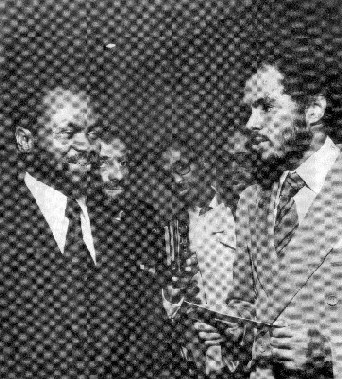
No Easy Victories: African Liberation and American Activists over a Half Century, 1950-2000
Gail Hovey, and Charles Cobb Jr.
Published by Africa World Press.
home
|
No Easy Victories: African Liberation and American Activists over a Half Century, 1950-2000 |
Edited by William Minter, Gail Hovey, and Charles Cobb Jr. Published by Africa World Press. |
|
An Unfinished Journey by William Minter The 1950s: Africa Solidarity Rising by Lisa Brock The 1960s: Making Connections by Mimi Edmunds
The 1970s: Expanding Networks by Joseph F. Jordan
The 1980s: The Anti-Apartheid Convergence by David Goodman
|
Featured TextThe following text is excerpted from No Easy Victories for web presentation on allAfrica.com and noeasyvictories.org. This text may be freely reproduced if credit is given to No Easy Victories. Please mention that the book is available from http://noeasyvictories.org and http://africaworldpressbooks.com. Robert Van Lierop: A Luta Continua
Robert Van Lierop, right, presents a check to President Samora Machel of Mozambique at the
United Nations in 1977 . The funds, raised from Van Lierop's film showings across the country, went to
build a health clinic in rural Niassa province. In the background, from left, are Valeriano Ferrpo,
James Garrett, and an unidentified man. Bob Van Lierop doesn't know how many copies of his film A Luta Continua (The Struggle Continues) were made, or how many times it was shown. But there is no doubt that for many in North America and Europe, the short film provided the definitive visual imagery that made the African liberation struggles come alive in the 1970s. A Luta Continua, portraying Mozambican guerrillas fighting against Portuguese colonialism, was filmed in 1971 in the liberated areas of Mozambique, across the border from Tanzania. A sequel, O Povo Organizado (The Organized People) was filmed shortly after Mozambique's independence in 1975 and released in 1976. The two films had a profound impact on black independent cinema in the United States in this period, yet their producer, Van Lierop, was not a filmmaker by training. He was a progressive African American lawyer based in New York, who launched the project in solidarity with Frelimo, opting to make the first film himself when he was unable to find a filmmaker willing to take on the task. He recruited his friend Bob Fletcher, who had been a photographer for SNCC, and credits him with most of the technical work on the film. In the 1960s, Van Lierop's political activities had included opposition to the Vietnam War and support work in New York for SNCC. SNCC later helped put him into contact with Eduardo Mondlane of Frelimo, who encouraged the film project and whose signature slogan, A luta continua, provided the title. Carol Ferry and Peter and Cora Weiss were all friends of Mondlane from the early 1960s, and they were among the key financial backers of the film. Between 1971 and 1978 Van Lierop gave up his law practice to dedicate himself entirely to the Mozambique film project and related activities of the Africa Information Service, an organization he co-founded in late 1972 with Prexy Nesbitt. The release of A Luta Continua in 1972 came just as the armed liberation struggle against Portugal was reaching its height. In the first half of the 1970s, before the Soweto uprising of 1976 focused solidarity efforts on South Africa, the figure of Amilcar Cabral and that of Samora Machel of Mozambique featured prominently in the rising identification with Africa among American activists, African Americans in particular. The African Liberation Day coalition, described in Joseph Jordan's chapter on the 1970s, is in part the outgrowth of Van Lierop's visit to liberated Mozambique in 1971. In a 2004 interview with William Minter, Van Lierop talked about his background and how he became involved in filming and distributing A Luta Continua. Robert Van LieropMy father was born in Suriname, and his father was Dutch. My grandfather had actually been in South Africa and had participated in the Boer War. My father had been to South Africa, subsequently, as a merchant seaman. Didn't like it. And he told me about it, about what was wrong with South Africa. He always told me a lot about other parts of the world and always talked about colonialism. He hated colonialism, and he had a lot of firsthand experience with colonialism. After working as a chauffeur and truck driver my father went into the dry cleaning business in Queens, and made a really successful go with that. I didn't want to take over my father's dry cleaning business when he retired, and he eventually sold it. Interestingly enough, he sold it for less money than he could have got. He had two buyers, one white and one black, and he sold it to the black person for less money because he felt that it was important to keep a business opportunity for black entrepreneurs. I was very much influenced by Malcolm X. I didn't know Malcolm, but I was very influenced by his journeys to Africa and what he saw and wrote about and spoke about. I became determined to go to Africa after law school. Having met Eduardo Mondlane and coming under his sway, one didn't easily walk away. He was a very captivating and larger-than-life personality. When Sharfudine Khan came to stay [to represent Frelimo at the United Nations in 1968], I was one of the people that Eduardo told him to contact. The three of us would sometimes talk about what could be done to increase people's knowledge and awareness of Frelimo. The idea of a complete media treatment came up - articles, photos, even a film documenting the struggle. I was not a film director, and I had no previous experience or knowledge about film. My initial assignment was to find somebody to do it. I asked quite a few people I knew who were filmmakers. None of them seemed to have time to take it on. I had been involved in the area of private offerings for theatrical ventures at the law firm where I worked, and I used that approach to raise money for the film. I actually met Carol Ferry because she was a client of the firm, and Peter Weiss did a lot of work with partners of the firm. And so Carol put money in the project, and Peter and Cora Weiss did; they were the two biggest sources of funds. The churches also put some money into the film, primarily the United Methodist Church, the Episcopal Church, and the United Presbyterian Church in the USA. I met Bob Fletcher, who had never made a film before either, but he had been a photographer with SNCC in the South, and he had a lot of experience doing that. And Bob agreed to go. The film was distributed by a lot of the African support committees, and also by the Southern African Committee and former Africa Research Group people, groups in Chicago. All of those people helped get the film out, as well as colleges and universities. I knew a lot of people in Europe also, and met even more - the Angola Comité in the Netherlands and groups in London and the Scandinavian countries. They helped get the film out there. The film was smuggled into South Africa and shown in Soweto before the uprising. The title of the film, A Luta Continua, began to appear scrawled on Soweto walls. Most people would have said that I was too loose with it, because I didn't keep much control over distribution. I just basically let people who were willing to go out with it, use it. And I asked that the money that was raised be sent to Frelimo. I left law and was working as a waiter down at the Village Vanguard [a club in Greenwich Village] at night, so that I'd be free in the daytime to do this work without a salary. Everything that we brought in from the film went back to the project. I just lived on the tips that I made as a waiter And some people who knew that I had been a lawyer already said, You did this when you were in law school! What are you doing? You're a lawyer now, why are you waiting on tables? But it just seemed like the right thing to do. I wanted to do this, and this was the only way that I could support myself without taking money from the project. Technically, we were not able to do what we had planned on doing because some of our equipment was lost crossing the river into Mozambique. We didn't have a sync camera, so we had to use a 16-millimeter spring-wound Bolex camera. That means, number one, very short takes, and number two, the sound could not be synced to the picture. So we had to do that in the editing process. Richard Skinner was the editor of the first film, and Richard had experience making television commercials, so he was very good at editing with quick cuts. It's very gratifying, because I think that everyone would like to feel in life that he or she has contributed to something meaningful. I never was able to keep records of how many copies were made and where it was shown and all of that. But I definitely feel good, because I think that we did contribute to something that was both good and important. |
This page is part of the No Easy Victories website.